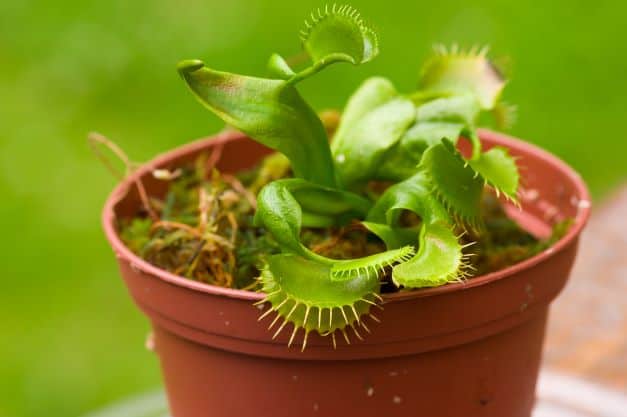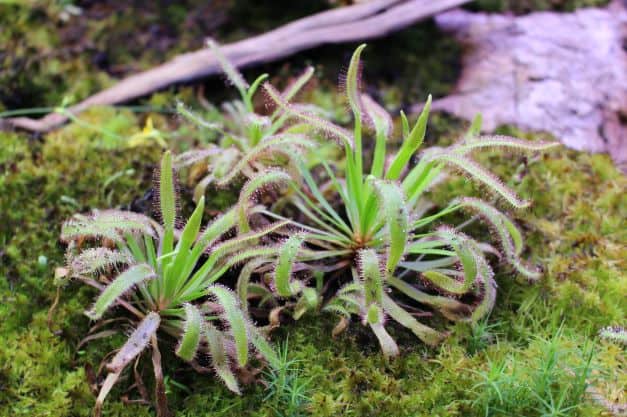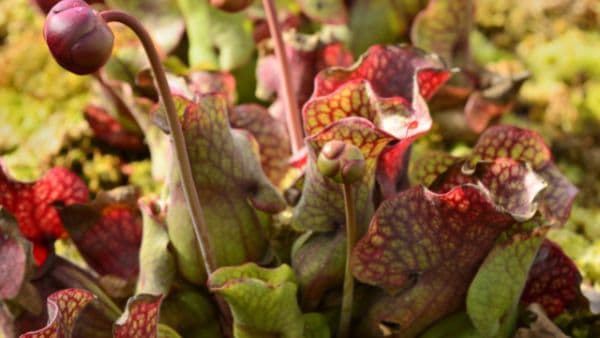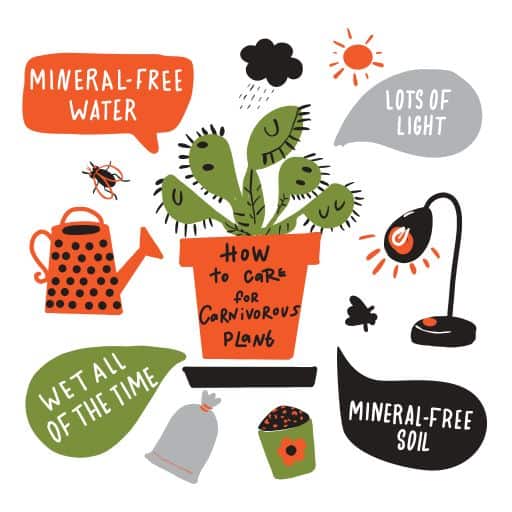Carnivorous plants are arguably the most fascinating plants you can grow. Just how much cooler is the fact that they’re getting most of their nutrients from feeding on living things compared to other plants that sustain themselves with photosynthesis. You might think that this difference makes them difficult to look after, but is it actually the reality? Are carnivorous plants easy to look after?
In general, carnivorous plants aren’t that much more difficult to look after than most other houseplants. While all species can be killed from the lack of care, species like the Venus flytrap are much more resilient and easier to look after compared to others, and even novice gardeners can properly look after them without encountering much trouble.
In this article, we’re going to present you with the general guidelines on properly taking care of carnivorous plants and explore several species that are the easiest to look after.
3 Carnivorous Plant Species That Are Easy To Look After
There are hundreds of carnivorous plant species categorized into 5 types by their mechanism of trapping. Plants with bladder-type traps are some of the most complex plant species to exist, and use vacuum suction to trap their prey.
Lobster-pot plants have traps that are very easy to enter, but impossible to leave, and flypaper-type traps work by secreting sticky mucilage which traps and asphyxiates whatever lands on it.
However, the most popular carnivorous plants belong to the snap trap type, which uses traps that snap shut after the insect lands on trigger hairs, and pitfall type plants, which have pitcher-shaped leaves containing a pool of nectar into which insects fall and eventually drown.
Here’s a list of 3 carnivorous plant species that are some of the easiest to care for:
1. Venus Flytrap (Dionaea muscipula)
This is probably the best-known carnivorous plant. It’s one of just two species utilizing snap-type traps. They are activated if prey touches two trigger hairs in a span of 20 seconds, or the same hair twice in rapid succession. Such an activation mechanism evolved to stop the Venus flytrap from shutting down if something that’s not prey, like dust, falls on the trigger hairs.
In nature, this species grows in the wetlands of North Carolina and South Carolina. Despite growing in such a limited area, Venus flytraps are easy to look for, and it combined with their cool appearance resulted in this species becoming one if not the most popular carnivorous plant species to grow at home.
The size of the plant and its traps varies by cultivar, but they usually grow up to 12 in (30 cm) tall and have up to 8 traps that can reach 1.5 in (3.81 cm) in diameter.
2. Cape Sundew (Drosera capensis)
Native to South Africa, Cape sundew uses a flypaper type trapping mechanism, which traps the prey with sticky mucilage before bending its leaves around it and digesting its nutrients. Its compact size, colorful tentacles, and low maintenance needs resulted in it becoming one of the most popular sundew plants in recent years.
Cape sundew grows in a rosette that reaches up to 10 in (25.4 cm) in diameter, with 2.75 in (7 cm) long tentacle-like leaves. During the summer, it blooms with as many as 50 light purple flowers, the number depending on how much you’re feeding it.
3. Purple Pitcher Plant (Sarracenia purpurea)
This plant uses pitfall-type traps, which are pitcher-shaped leaves into which the prey falls before being drowned in accumulated rainwater. In the wild, the water is inhabited by many organisms including bacteria, protists, protozoa, and midges. In the first year, before such a community comes to be, the plant produces enzymes like protease and hydrolase that help digest the prey.
Talking about the prey, this species is capable of capturing many different animals, ranging from ants and flies to hornets and even young spotted salamanders. It’s made possible by large deep red pitchers that grow up to 12 in (30.48 cm) long. The plant itself grows up to 18 in (45.72 cm) tall and 24 in (60.96 cm) wide.
As it’s capable of growing in the cold climate of Canada, it’s extremely resilient compared to most carnivorous plant species and is one of the easiest to properly take care of.
How to Take Care of Carnivorous Plants
While there are many different species of carnivorous plants, most of those available for purchase have similar requirements. It’s always best to research the specific species you want to grow, but here are the general guidelines for looking after a carnivorous plant.
Soil
There are many aquatic or semi-aquatic species of carnivorous plants, but most people are growing terrestrial species that grow in wetlands. Most importantly, they grow in nutrient-poor soil that doesn’t contain many minerals and isn’t suited for usual plants.
It’s because carnivorous plants have evolved to meet all their nutrient needs from capturing prey. That’s why general plant soil is unfit for growing carnivorous plants, and instead, you should try getting your hands on peat moss. It’s also recommended to mix it with sharp sand or perlite soil to guarantee appropriate water retention.
Finally, don’t use fertilizers, as they’re going to do more harm than good and can even kill your carnivorous plant.
Pots and Planters
There are many types of pots you can use for your carnivorous plant, but there are two requirements they have to follow. First of all, they have to have drainage. Some pots don’t have holes and won’t let surplus water leave the soil, which could lead to rotting roots. If you have a pot that you’d love to use, but it doesn’t have drainage, you can simply drill or puncture the holes yourself.
The second requirement is that the pot can’t be made of porous material. Porous pots, including various ceramics ranging from stoneware to earthenware, can soak up the minerals, eventually building them up over time and harming your plant. So, what planters are suitable for growing carnivorous plants?
Plastic
The most popular choice is plastic – planters of all shapes and sizes are readily found in all gardening stores. However, if you want to switch it up a bit, you could choose a resin pot, a type of planter which is becoming more and more popular in recent years. It’s made of, well, resin blends, and is comparable to plastic.
Resin
Where resin planters outshine their plastic counterparts is in appearance. Resin planters can mimic other materials, including ceramics and even metals, which gives you more options in deciding what kind of general design you’re aiming for. Additionally, the resin is much more environmentally friendly compared to plastic, so that’s also something to keep in mind.
Stoneware and Earthenware
You can also use stoneware and earthenware pots that are fully glazed. The glaze makes ceramics non-porous, which stops them from building up minerals that could harm your plant. Depending on the plant, you can also use glass planters, which most often come in the form of terrariums.
Terrarium
There are even high-tech terrariums, which come with their own lighting system that aids the growth of your plant. Such are best if you’re growing a species which requires a lot of sunlight at home and can’t give it sufficient sunlight.
Some terrariums even have programmable lights that you can control, changing the intensity and even the times of the day when they’re active. Keep in mind that this option is much more expensive compared to other planters, and is only necessary if you want to grow a tropical species when living in a more temperate climate.
Light
Most carnivorous plant species grow in temperate climates, but they’re still getting a lot of sun. If you’re growing such a plant indoors, you have to be aware of it getting enough sunlight. It’s best to keep it on a window sill so it can soak up as much light as possible.
If your windows are facing North and you aren’t getting that much sunlight inside, it would be best to leave the plant outside during the day, only if the climate allows. Most carnivorous plants require at least 6 hours of sunlight every day, and it can be difficult to fulfill depending on where you live.
However, you can use LED lights to supplement the lack of sunlight. Here’s a chart with some of the most frequently grown carnivorous plants and how much light they need:
| Genus/Species | Lighting Requirement | Can Use Only Blue/Red Light |
| Cephalotus | 15,000 to 25,000 lux | Yes |
| Dionaea | 15,000 to 25,000 lux | Yes |
| Drosera (most species) | 15,000 to 25,000 lux | Use Caution |
| D. adelae | 8,000 to 15,000 lux | Use Caution |
| D. schizandra | ~3,000 lux | Not Recommended |
| D. prolifera | 8,000 to 15,000 lux | Use Caution |
| Genlisea | 8,000 to 15,000 lux | Use Caution |
| Heliamphora | 15,000 to 25,000 lux | Yes |
| Nepenthes | 8,000 to 15,000 lux | Yes |
| Pinguicula (Mexican) | 8,000 to 15,000 lux | Use Caution |
| Pinguicula (temperate) | 8,000 to 15,000 lux | Use Caution |
| Sarracenia seedlings | 15,000 to 25,000 lux | Yes |
| Utricularia | 8,000 to 15,000 lux | Use Caution |
Here you can find more information about the lighting requirements of carnivorous plants.
Water
Most species grow in wetlands, meaning the soil has to be wet at all times. Don’t ever let it dry out, if the soil ever reaches such a point, it’s too late and your plant will already be damaged. Water regularly, and it’s recommended to keep your carnivorous plants in pots that are standing in saucers or trays filled with water ¼ or even ½ way up the pot.
As most carnivorous plants don’t require nutrients in their soil, water them with soft water that doesn’t contain minerals, like rainwater, distilled water, or tap water that’s been boiled and cooled off. If you can’t acquire soft water for some time, you can use hard water, but change the soil frequently to avoid a mineral buildup.
Most carnivorous plant hobbyists install water softening systems at home, which makes tap water soft by filtering out the minerals. It makes it very convenient to get suitable water for their plants at home without having to collect rainwater or buy distilled water.
Food
Feeding their carnivorous plants is what draws most people to start growing them in the first place. However, most species don’t require additional feeding for the most part and capture sufficient prey on their own. Additional feeding might be required during the blooming stages when the plant needs more nutrients to produce flowers and in some cases, fruits.
If you’re growing your plant inside and there aren’t enough bugs for it to capture to get all the necessary nutrients, you can consider feeding it. However, capturing insects is tiresome and time-consuming, and buying them alive requires you to take care of them until you plan on turning them into dinner.
However, there are many food supplements specifically designed for carnivorous plants. Some come in the shape of gel cubes, others in liquid form that you feed with using a dropper. Such supplements often contain all the necessary nutrients that a plant would get from catching prey, and some contain even additional nutrition which can foster the plant’s growth.
Don’t ever attempt to feed your carnivorous plant human food. While the trap will most likely work, for example, the traps of the Venus flytrap will shut close, it won’t be able to digest the food, which eventually will start rotting. Soon after, the plant itself will follow suit and quickly die.
Dormancy
Most carnivorous plant species go into dormancy starting in the early fall months, usually October or November. The drop in temperature and sunlight hours make the plant go into a state of rest and growth inhibition. When you start seeing your plant dropping leaves, put it into a darker and colder environment and start watering it less.
Instead of maintaining wet soil, only water when it starts drying out and pour enough water just to get it damp. After a dormancy period ranging from 2 to 2 ½ months, the plant will be rested and ready to grow for the new season. It usually happens in the late winter months or early Spring.
When the winter is over, discard all dead leaves and bring the plant out on your window sill or plant it back outside if you were growing it there. Start caring for it as you did before until the next dormancy period comes.
Frequently Asked Questions (FAQ)
(Q): How Often To Feed Venus Flytrap?
(A): If you’re growing it outside, you shouldn’t need to ever feed it, especially during summers when there’s an abundance of prey just waiting to be captured. However, if you’re keeping it inside, or just want to have some fun and see the traps snap close, you can feed it once every week.
(Q): What Are Carnivorous Plant Cultivars?
(A): There are cultivars of all plants that are commonly grown, including many species of carnivorous plants. Cultivars are varieties of a plant that result from selective breeding aiming to produce some kind of trait. For example, the “Akai Ryu” Venus flytrap is a cultivar that has dark red traps, unlike most flytraps which have green traps.
Final Words
Carnivorous plants are some of the most exciting plants you can grow, and we hope this article helped you understand what it takes to properly take care of them. Good luck in your carnivorous plant journey!




